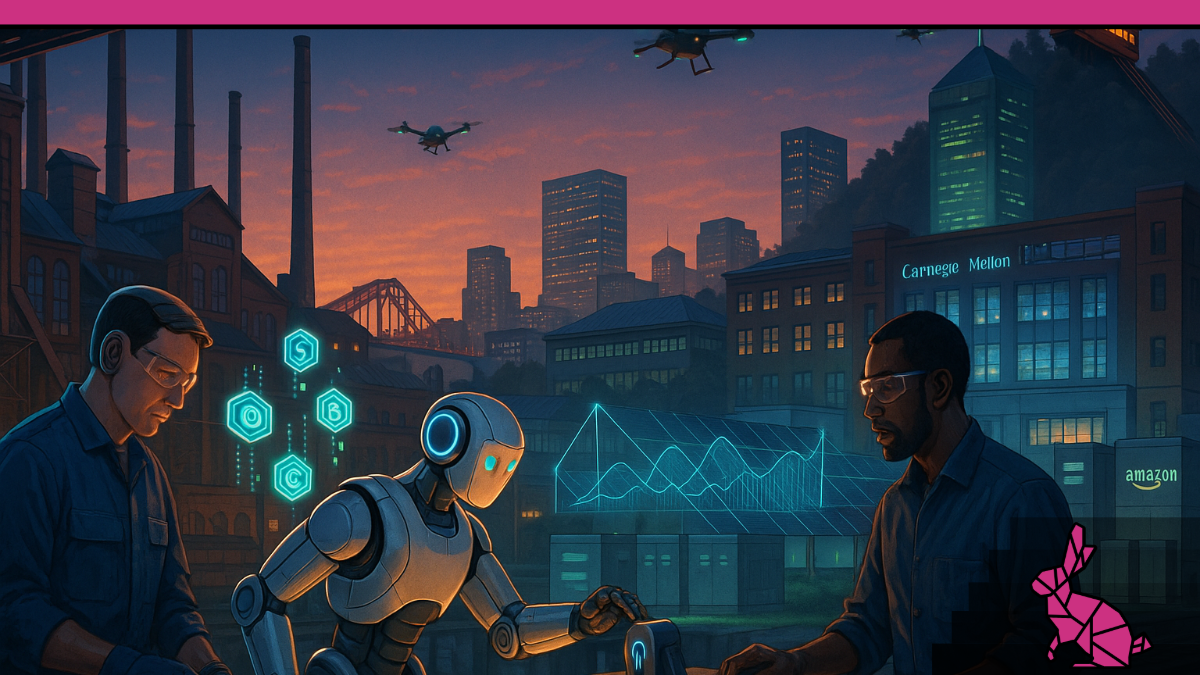Technology

Technology
Does Bitcoin Really Store Energy Or Just the Illusion of It?
by Martin Goetzinger
on Nov 09 2025
Bitcoin doesn’t store energy like a battery, it immortalizes the proof that energy was burned. From gold’s atoms to Bitcoin’s math, this is the story of unforgeable costliness in the digital age.

Technology
by Martin Goetzinger
on Oct 23 2025
Bitcoin: Digital gold or environmental nightmare? This balanced guide dives into crypto's highs (decentralization, scarcity) and lows (volatility, energy use)—plus 2025's game-changing GENIUS Act for stablecoins. Perfect for beginners wondering if it's revolution or risk.

Technology
PITTSBURGH: The New Industrial Revolution - When Smarter Robots Spark Human Opportunity
by Martin Goetzinger
on Jul 14 2025
We’re Entering The New Industrial Revolution
We’re entering The New Industrial Revolution—not powered by steam or steel mills, but by smart, even proto-sentient robots; decentralized ledgers; and clean, resilient energy. Nowhere is this transformation more visible than in Pittsburgh, where a $75 billion AI + energy infrastructure investment (announced July 15, 2025) is catalyzing new industries and human jobs. From Carnegie Mellon’s research labs to Amazon’s data centers, from the AI Strike Team to the Nippon Steel–U.S. Steel partnership, Pittsburgh is poised to become the world’s next AI hub.
1. Pittsburgh’s Robotics Renaissance
Carnegie Mellon University (CMU) has long been the cradle of robotics innovation, housing world-class labs in autonomous vehicles, humanoid robots, and computer vision. Today, CMU researchers are collaborating with the AI Strike Team—an industry consortium formed to shepherd Pittsburgh’s AI strategy—to spin out startups that build cobots capable of dynamic self-diagnosis and collaborative decision-making.
2. New Human Jobs Rising in Steel City
The surge of robotics and AI funding translates into hundreds of thousands of roles across the region. Key examples include:
Ethics auditors to oversee AI decision-making processes.
Collaboration coaches to facilitate human-robot teamwork.
Energy orchestrators to manage decentralized power grids.
Each position blends technical fluency—ethics, blockchain, energy systems—with Pittsburgh’s deep manufacturing and academic roots.
3. Crypto-Backed Trust in the Steel City
In the near future, when Pittsburgh’s robots begin “paying” each other for maintenance or data access, blockchain platforms developed at Carnegie Mellon University CyLab and piloted by AI Strike Team members could provide transparency with future applications such as:
Machine-to-Machine Micropayments: Cobots at the PPG Paints Arena use Ethereum-style smart contracts to settle energy fees with local microgrids.
Data Provenance Tokens: Sensor streams from U.S. Steel’s Mon Valley works are timestamped on private ledgers, ensuring every robotic adjustment is auditable.
These initiatives will rely on local firms + university spin-outs, and organizations like the AI Strike Team will help bring these ideas to market.
4. Energizing Pittsburgh’s Future
Pittsburgh’s legacy as an energy hub is being reborn with:
Decentralized Microgrids: The Hazelwood Green redevelopment is slated to include a renewable-energy “energy district” with solar + storage microgrid capabilities. The DOE’s NETL page lists Hazelwood Green as one of four Pittsburgh-area distributed-energy/microgrid projects currently in development. There may be potential for a partnership with CMU’s Wilton E. Scott Institute for Energy Innovation around AI + energy research.
Data-Center Power Optimization: Amazon Web Services (AWS) has committed $20 billion to expand PA data-center campuses, and AWS is investing heavily in renewable energy—solar farms, on-site solar, and nuclear partnerships. This could include co-development efforts with CMU’s PowerLab for fuel-cell backups or demand-response algorithms.
Steel-Mill Electrification: Nippon Steel Corporation and U.S. Steel have announced large-scale partnerships—reports cite roughly $14 billion of joint investments in modernizing U.S. steel infrastructure. This may include retrofitting blast furnaces with AI-managed electric arc technologies, reducing coal dependence.
These energy advances will ensure that robots—and the humans who build and manage them—operate on clean, resilient power.
5. Pittsburgh’s Human Advantage
Despite the march of autonomous systems, Pittsburgh’s brightest asset remains its people:
Cross-Sector Fluency: CMU students, U.S. Steel engineers, and Amazon technologists are co-located in innovation districts, fostering rapid knowledge exchange.
Responsible Innovation: The AI Strike Team’s governance framework—drafted alongside local unions and civic leaders—ensures equitable job growth.
Lifelong Learning Ecosystem: From community-college upskilling programs to CMU’s executive courses on AI ethics, Pittsburgh is equipping its workforce for continuous transformation.
Full List of Investors
Anthropic - $1 million
Blackstone - $25 billion
Brookfield - $3 billion
Capital Power - $3 billion
Constellation Energy - $2.4 billion
CoreWeave - $6 billion
Energy Capital Partners - $5 billion
Energy Innovation Center Infrastructure Academy
Enbridge - $1 billion
Equinor - $1.6 billion
First Energy - $15 billion
Frontier Group - $3.2 billion
GE Vernova - $100 million
Google
Homer City Redevelopment - $15 billion
Meta - $2.5 million
PA Data Center Partners and Powerhouse Data Centers - $15 billion
PPL Corporation - $6.8 billion
TC Energy - $400 million
Westinghouse Electric Company - $6 billion
Forging the Steel City of Tomorrow
With $75 billion in AI and energy investments, anchored by Carnegie Mellon University, Amazon, the AI Strike Team, and the Nippon Steel–U.S. Steel partnership, Pittsburgh is rewriting the playbook on industrial revolutions. New jobs such as ethics auditors, collaboration coaches, and energy orchestrators will define the next generation of human–machine collaboration.
By harnessing robotics, crypto, and clean energy, Pittsburgh proves that the New Industrial Revolution is not just about smarter machines, but about smarter people working alongside them.
Technology
The End of Fiat and the Rise of the Portable Life
by Martin Goetzinger
on Nov 21 2024
The world is shifting under our feet, and it’s not just the headlines screaming about inflation or debt. There’s a deeper pattern emerging—one that’s reshaping money, work, and power itself. Fiat currency, the government-backed money we’ve trusted for decades, is crumbling. In its place, a new system of “crypto rails” powered by stablecoins is taking shape. This isn’t just about digital dollars—it’s about a future where mobility defines wealth, labor, and influence. And if you’re not paying attention, you might get left behind.
Fiat Is Bleeding Out
Fiat currency—dollars, euros, yen—works because we all agree it does. It’s not gold, oil, or anything tangible; it’s faith in governments. But that faith is cracking:
Central banks have printed over $10 trillion since 2020, diluting purchasing power globally.
Inflation has outpaced wage growth in 80% of OECD countries since 2022.
National debts are ballooning—U.S. debt alone hit $35 trillion in 2024, with no end in sight.
In places like Argentina and Zimbabwe, locals are ditching their currencies for digital dollars to survive hyperinflation.
The response? Governments and corporations aren’t doubling down on fiat. They’re building something else: crypto-native infrastructure that’s borderless, instant, and programmable. At the heart of this shift are stablecoins.
Stablecoins: The New Dollar, Redefined
Stablecoins like USDC and USDT are digital assets pegged to the dollar, living entirely on the blockchain. They’re not just a tech fad—they’re rewriting the rules of money. Here’s why:
Instant: Transfers clear in seconds, not days.
Global: Usable anywhere with an internet connection.
Decentralized: Not tied to one nation’s banking system.
Backed by assets: Increasingly tied to U.S. Treasury bills, offering yield in a way your bank account doesn’t.
This isn’t niche anymore. Stablecoins processed over $1.2 trillion in on-chain transactions in 2024, surpassing Visa’s volume. PayPal, Stripe, and Shopify now integrate them. And governments? They’re not banning stablecoins—they’re legitimizing them.
In May 2025, U.S. Senator Bill Hagerty introduced the GENIUS Act, a bipartisan bill to regulate stablecoins as legal payment instruments backed by U.S. Treasuries. It sailed through the Senate in June with 82 votes. Meanwhile, the STABLE Act is gaining traction in the House, setting guardrails for these “digital dollars” (Source: House Financial Services Committee, 2025). As Hagerty said in a Senate hearing, “Stablecoins are not a threat to the dollar—they’re its next evolution” (Source: C-SPAN, May 15, 2025).
Dollar Diplomacy 2.0
Stablecoins aren’t just a financial tool; they’re a geopolitical weapon. In countries like Argentina, where inflation hit 280% in 2024, or Turkey, where the lira lost 40% of its value, people aren’t waiting for banks to save them. They’re using USDC and USDT to buy groceries, pay rent, and escape currency collapse. This is necessity, not ideology.
The U.S. sees the opportunity. Stablecoins extend American financial influence without embassies or armies. As Treasury Secretary Janet Yellen noted in a 2024 speech, “Stablecoins can strengthen the dollar’s global dominance if we regulate them wisely”. It’s dollar diplomacy for the digital age, with apps and wallets as the new ambassadors.
Real Stories, Real Impact
Consider Maria, a freelance graphic designer in Buenos Aires. Her clients pay her in USDC because Argentina’s peso lost half its value last year. “I can’t trust banks here,” she told CoinDesk in 2025. “Stablecoins let me save in dollars and spend instantly, anywhere.” Or take Ade, a software developer in Lagos, Nigeria, who gets paid in USDT to bypass banking fees and inflation. “It’s not crypto hype—it’s survival,” he shared on X (Source: X post, @AdeTechNG, March 2025).
These aren’t edge cases. Chainalysis reports that stablecoin adoption in emerging markets grew 300% from 2022 to 2025. People aren’t choosing stablecoins because they’re tech nerds—they’re choosing them because fiat is failing them.
The Portable Life: Wealth and Work Unmoored
Here’s where the shift gets personal. The elites—politicians, tech moguls, think tanks—are pushing a subtle but unmistakable narrative: “Own nothing, be happy.” “Homeownership is outdated.” “Digital assets are the future.” This isn’t just rhetoric; it’s a blueprint for a world where wealth and work are untethered from place.
Wealth is going mobile: Real estate ties you to one spot, subject to local laws and market swings. A crypto wallet? It moves with you, borderless and instant.
Work is following suit: Remote work surged from 7% to 35% of global jobs post-COVID and keeps climbing (Source: McKinsey, 2025). AI and automation are breaking jobs into tasks—gig-based, temporary, location-agnostic.
The vulnerable are stuck: If you’re in a location-tied job—manufacturing, teaching, healthcare—you’re anchored while the world goes fluid. Freelancers in Argentina or Nigeria are already living the portable life, paid in stablecoins, free from local banking traps.
If wealth and work are portable, but you’re not, you’re at risk of being left behind. As tech investor Balaji Srinivasan put it, “The future belongs to those who can move—their money, their work, their lives” (Source: X post, @balajis, January 2025).
Prepare for What’s Coming
This isn’t financial advice or fearmongering—it’s a call to see the pattern. Fiat is leaking, and crypto rails are the new infrastructure. Laws like the GENIUS Act and platforms like PayPal are embedding stablecoins into the system. The shift is happening now.
Ask yourself: How is your company preparing for a stablecoin-driven future? Are you ready to operate in a world where money and work move faster than borders? The tech is here, the laws are catching up, and the world is moving. Don’t get stuck.

